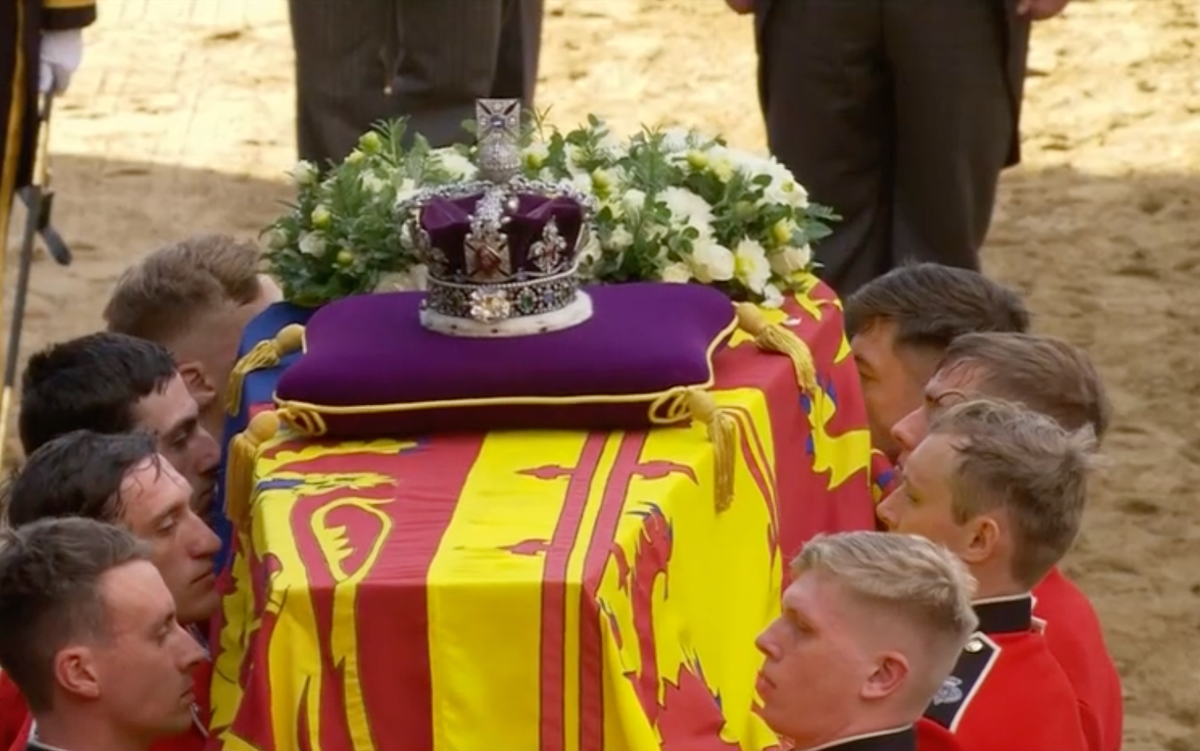
The coffin of Queen Elizabeth II has arrived at Westminster Hall after a 40-minute procession from Buckingham Palace.
The coffin was draped in the Royal Standard, with the Imperial State Crown on a velvet cushion and a wreath of flowers atop.
It was carried on a gun carriage of King’s Troop Royal Horse Artillery and made its journey to the sound of funeral marches played by the Band of the Scots Guards and the Band of the Grenadier Guards.
The Queen died on Thursday (8 September) at the age of 96 at her Balmoral estate, after 70 years on the throne.
Her coffin was flown from Edinburgh to London on Tuesday night (13 September) and has now left Buckingham Palace for the last time.
But what is the significance of the Imperial State Crown and the flowers that laid on her coffin?
What is the Imperial State Crown?
The Imperial State Crown is one of the Crown Jewels of the UK and represents the sovereignty of the monarch.
While the crown has existed in various forms in the past, the current version was made in 1937 and was worn by the Queen after her coronation in 1953.

It has also been used in other State occasions, including the tate Opening of Parliament.
The crown featured in one of the public’s favourite moments of the Queen, when she appeared in a BBC documentary in 2018 about her coronation.
She famously manhandled the heavy crown, pulling it towards her and turning it around, adding: “This is what I do when I wear it.”
What jewels are on the Imperial State Crown?
More than 2,900 precious stones adorn the crown, including the Cullinan II diamond, St Edward’s Sapphire, the Stuart Sapphire and the Black Prince’s Ruby.
It is covered with 1,363 brilliant-cut, 1,273 rose-cut and 142 table-cut diamonds, 277 pearls, 17 sapphires, 11 emeralds, and four other rubies.
It also has a purple velvet cap with an ermine border and is lined with white silk.
The Cullinan II diamond is also known as the Second Star of Africa. It was part of the largest gem-quality rough diamond ever found, which was originally discovered in Cullinan, South Africa, in 1905.

The cushion-cut brilliant diamond with 66 facets was bought by the South African government and presented it to Queen Mary in 1910, alongside the Culinan I.
St Edward’s Sapphire, an octagonal rose-cut sapphire that sits in the centre of the cross at the top of the crown, is older than any other gemstone in the royal collection and is thought to have belonged to Edward the Confessor, one of the last Anglo-Saxon English kings.
Meanwhile, the Stuart Sapphire is thought to have belonged to Charles II and may have originated from Asia.
Lastly, the Black Prince’s Ruby takes pride of place on the Imperial State Crown. It has been in the possession of England’s rulers since 1367, when it was given to Edward of Woodstock – who was known as the “Black Prince”.
It is thought to have originated from present day Afghanistan and Tajikstan.
What were the flowers in the wreath?
The wreath placed atop the Queen’s coffin was made of pine from the gardens of Balmoral and lavender from the grounds of Windsor.
It also contained white roses and dahlias, as well as rosemary and pittosporum.
The blooms in the wreath are different from those that appeared in the one that sat atop the Queen’s casket when it travelled along the Royal Mile in Edinburgh on Monday (12 September).
At the time, the wreath had sweet peas, dahlias, phlox, white heather and pine fir.
Sweet peas, which represent departures and goobyes, were also placed in the wreath on the late Duke of Edinburgh’s coffin in 2021. They are the birth flower of April, the month in which the Queen’s birthday falls.
Additional reporting by PA







